Kittens are numbered left to right.
Tonkinese color develops over time. Their coat pattern is created by heat sensitive genes and since body temperature varies with age so does the color of Tonkinese. Usually Tonks get darker with age with Blue kittens some times being an exception. Blue kittens some times start out a bit brownish and then lighten or change shade. Weather (cold vs heat) may effect color. Breeding cats can have their color change. But a neutered tonk who suddenly gets lighter when its environment has not changed may be ill. It may have a higher body temperature due to illness which is effecting its color.
This page shows 4 Tonkinese kittens from birth and discusses what color they are week to week as they develop. Even when it is clear what color they all are, the previous comments will not be changed. The comments are reflecting a journey of discovery. The kittens can be all four basic colors in two of the three coat patterns. These 4 kittens can be: Natural Point, Natural Mink, Blue Point, Blue Mink, Champagne Point, Champagne Mink, Platinum Point, Platinum Mink. They can not be a Natural Solid, Blue Solid, Champagne Solid, or Platinum Solid.
Some people think Tonkinese kittens are born all white. They are not. Tonks kittens are born in a variety of body color/shades. But their coat is uniform color. They lack the distinctive "point" color at birth. By points we mean the darker color of the extremities: nose leather, paws, tail, and ears. The various Tonkinese coat pattern genes suppress body color by temperature. The amount of body color suppression varies among the three coat patters of Point, Mink, and Solid. In the womb, the kittens are all one temperature so at birth the color of the body and points are one color. Once they are outside the womb, their point color starts to get darker as the kittens develop a variation of body temperature in different parts of the body.
Useful information is the true genetic color names of the 4 base colors. Especially for Day 4 the Black vs Brow aspect is important.
- Natural is Black/Dense
- Blue is Black/Dilute
- Champagne is Brown/Dense
- Platinum is Brown/Dilute
Kittens 1 and 2 are males and 3 and 4 are females
Development: This litter was a full term litter and litters develop at different rates. So this litter's development is just one example.
More information about Tonkinese colors can be found on the Tonkinese Breed Association web site.
D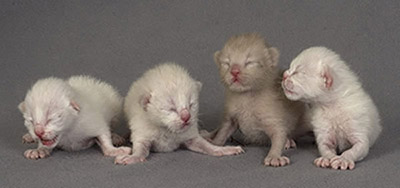 ay 1: ay 1:
left to right
Only kitten 3 has significantly different color and its hard to distinguish the other 3. Kitten 3 is likely to be a Natural Mink and the other 3 impossible to guess.
Development: Eyes are closed. Ears are on the sides of the head, low, and pretty closed. At birth and some that are less developed at birth will have ears flat against the head.
Kittens do not urinate and defecate on their own. Their mothers lick that area to stimulate their releasing of such and ingest it to keep their nesting area clean. This is a survival instinct to keep predators from finding them. |
D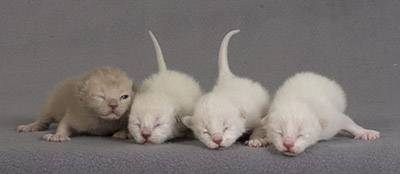 ay 4: ay 4:
All 4 are now at least slightly different and will be photographed in the same consistent order. The first "point" to get some color is the nose leather. Kittens 1 and 2 have much darker nose leather than 3 and 4. I expect 1 and 2 to be either a Natural or Blue and 3 and 4 to be a Champagne or Platinum. This is because I find the 2 Black colors get nose leather color sooner than the 2 Brown colors (see real genetic color names above). The Dense/Dilute aspect of the color I do not find important this young. Again #1 really seems to be a Natural Mink.
Development: One eye starting to open. Ears pretty much the same. Claws do not retract and they have very long nails with which to hang on to mother when nursing. |
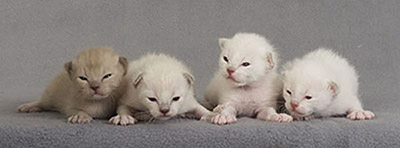 Week 1. Week 1.
Kittens 1 and 2 now have a little point color on the edges of their ears. Kitten 3 and 4 have very little ear edge color.
Kitten 3 and 4 both have much lighter nose leather than 1 and 2 but 3 seems a little darker than 4. This could mean 3 is a champagne and 4 platinum or it could be just individual variance.
Day 4 I said based on nose leather, Number 1 could be a Natural or Blue but again 1 seems to be a Natural Mink.
Development: Eyes all open. Ears starting to move up the head proportionally. |
Week 2.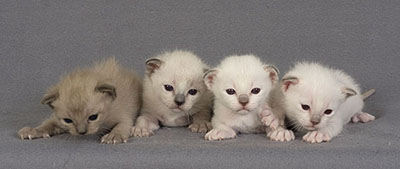 
Nose point is starting to get bigger. Ears, tails, and paws all have more color. L to R One is a mink and four a point. Two and three still not clear. Remember none are solids.
At this point the guess for colors are:
- 1 is a Natural Mink
- 2 is a Blue. Note the nose leather of 2 looks almost darker than 1 but the paw pads clearly indicate 1 is a Natural and 2 a Blue. Still not sure if 2 is a mink or point.
- 4 is a Platinum Point
- 3 is not clear. The tail of 3 is darker than 4 but the paw pads look the same. So 3 could be a champagne or platinum and a point or mink.
D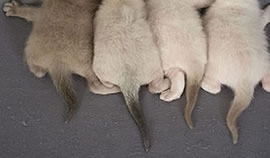 evelopment: evelopment: 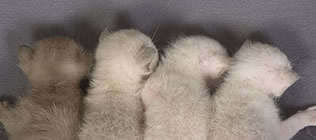 Ears more open but just a little response to noise. They do not seem to see and no response to movement in front of their eyes. Ears more open but just a little response to noise. They do not seem to see and no response to movement in front of their eyes. |
Week 3.
Point 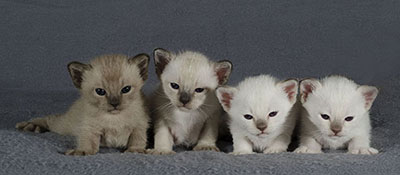 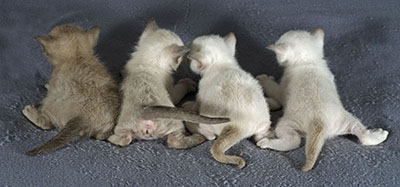 color continues to expand in area. Tail fur continues to loose some fluff and be replaced with tighter darker fur. Number 2 body color is darkening a bit whereas the other 3 are about the same as last week. 3 and 4 seem the same color and this week look more like champagnes than platinums. Who knows next week. color continues to expand in area. Tail fur continues to loose some fluff and be replaced with tighter darker fur. Number 2 body color is darkening a bit whereas the other 3 are about the same as last week. 3 and 4 seem the same color and this week look more like champagnes than platinums. Who knows next week.
Development: On a daily basis they are changing. They are walking (not always steady) and alert to the world around them. Their nails can now retract some so their nails do not catch on the towel which makes walking easier. Their nails have been clipped too. They come to the opening of their box and look out. They touch each other and the sides of their box and may even use their tongue to touch each other. Not really grooming but touching. They probably do not see well but they see something. Their ears are open and much higher on the head. They hear more than last week. They hear better than they see. They now act and look like kittens as their senses come alive.
.
|
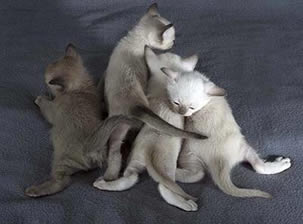 W W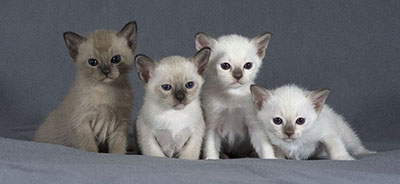 eek 4. eek 4.
Number 2 does not look as blue as last week and seems more of a natural this week. Who knows. 2's mask is spreading out from his nose and is the most visible of the 4. 1 is a more subtle color contrast to the body color but it is there. Remember 1 and 2 are the Black gene. 3 and 4 are the Brown gene and get color a little later. We see little mask color past the nose for 3 and 4. We might see their mask expand next week.
Development: They have been out of the box for days and some even climb up on top of the box. They are walking all around their cage. Audio and vision improve but they still do not follow the tease when waved in front of them. The tails are very active and that shot was a pile of activity.
|
Week 5.
1 and 2 are clearly Naturals and 3 and 4 Champagnes. 2 had a nose of a Natural early on but the paw pads, coat tone and tail looked Blue. Now it has lost the blue cast. Note 1 and 2 continue to have their facial mask expand where as 3 and 4 have little color beyond their nose. Yet as adult 3 and 4 will be almost as dark as 1 and 2 and the same size in area.
Development: Week 4 to 5 is the messy week. They were introduced to food starting week 4. Many times kittens will try and bury their food before ever eating the first time. Felines have a very strong instinct to keep their area clean so predators can't find them. But that does not seem to extend to cleaning up after missing the litter box. Once they starting eating and having normal stools, they can urinate and defecate without mom stimulating them. They can be really messy with their first stools which may be orange and tar like. They are not sure if litter is to be played with, eaten or used for potty. But already by week 5 they have only occasional accidents and use their litter well.
T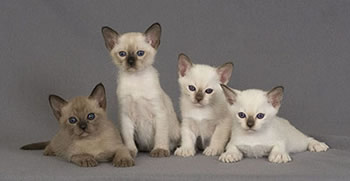 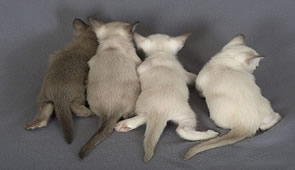 hey are now "popcorning". A term we use to describe their jumping around with stiff legs some times even backwards. They remind us of popcorn popping. They are not shy and busy exploring beyond their cage and curious about objects they find. hey are now "popcorning". A term we use to describe their jumping around with stiff legs some times even backwards. They remind us of popcorn popping. They are not shy and busy exploring beyond their cage and curious about objects they find.
They can now follow a tease and some even respond to seeing them selves in a mirror. They play hard but still nap a lot as they wear them selves out.
We may have 4 females. 2 looks more like a female and 1 is not for sure either way. |
W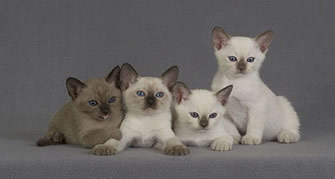 eek 6. eek 6.
All are definitely girls.
Color development is changing at a slower rate now. You can see a little color in the paws of 3 & 4 whereas 2 has a lot of paw color.
Development. Their senses are functioning very well. They not only can watch a tease all 4 can move their head in unison when moving the tease left to right. Number 1 (who had her own solo shot) has now decided to be brave and get off the table if she is not kept busy. I expect the rest will do the same the next photo shot.
The still do not like to be picked up high in the air. Although tonks love high places as adults, kittens find heights scary unless they get there on their own. And if they do climb up some thing, may cry to get put back down as down seems harder than up. |
W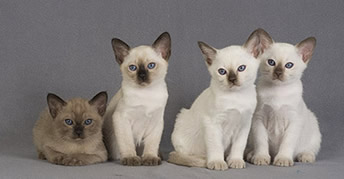 >eek 7. >eek 7.
Color continues to spread but again more slowly now.
Development. Continues to advance quickly. They are now the herd of thundering elephants. It is one of life's mysteries how kittens who weight just a little and can be very silent when desired, make them selves sound loud and like elephants when they run. In one day all 4 started to climb the cat tree and by day's end could get to the top of the 5 cat foot tree. All could get back down too. All senses are excellent now. |
We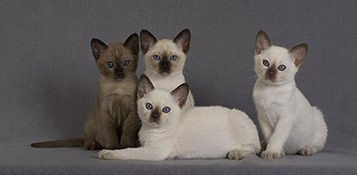 ek 8. ek 8.
I want to draw attention to the difference between the color development of the points. The second photo is the back of the ears of the Natural Point (#2) and a Champagne Point (#3). There is a tone difference since 2 is a black/dense genetically which is darker than a brown/dense. But also the color coverage of the ear for the black (Natural) is much further down to the base then the brown (Champagne). Adult Champagne's back of ear will be totally the same color from tip to base. But right now the Champagne base of ear color is much lighter.
Ear color. Photo 3 shows the eye color of the 2 Naturals. All kittens are born with blue eyes. But some time after week 6, the minks and solids start to have their eye color change. The Natural mink (1) is starting to get a little aqua and the Natural Point (2) still has blue eyes.
Development. 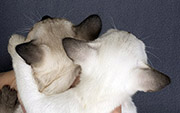 T T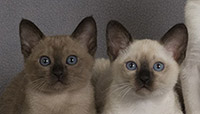 hey have grown a lot and are much more active. They sleep less and are harder to keep on the table and look at the camera. They also have started my truly least favorite behavior. Biting. So we are now trying to teach them what they can bite (food and toys) and what not to bite (us). hey have grown a lot and are much more active. They sleep less and are harder to keep on the table and look at the camera. They also have started my truly least favorite behavior. Biting. So we are now trying to teach them what they can bite (food and toys) and what not to bite (us). |
W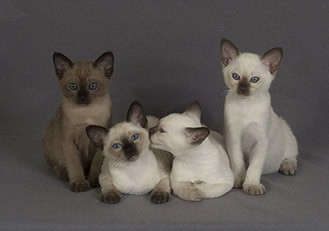 eek 9. eek 9.
Number 3 & 4 are now starting to get a little color on the cheeks and around the eyes.
Development: They are really getting bigger. The weight 2 pounds from 7 to 12 ounces. That is good sized for females.
They do not want to stay on the table when we photograph them. They want to explore every where. They are playing a lot with the tube that has a ball in it that lights up with movement. Both eye sight and coordination is now quite good. They climb the cat tree with ease now, but still do not tend to jump big distances. They are making progress about biting etiquette but toes under covers are still a target. |
W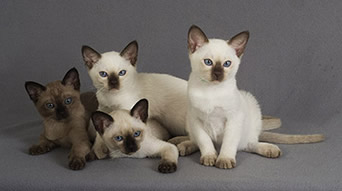 eek 10. eek 10.
Color change is very slow now.
Development. Their bodies are getting longer as well as heavier. I find it hard to carry all 4, so both of us split carrying some. This was a challenging photo. Now they typically do not all sleep at the same time. Its not just that they sleep less but its staggered so usually someone is awake. Their attention span is nil now. The tease only gets them to focus briefly. They want off the table and explore. Hence photos of all 4 is much harder now. |
W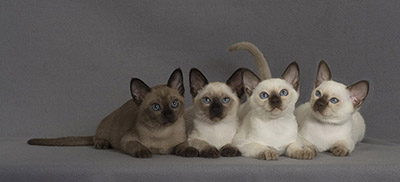 eek 11. eek 11.
The Naturals have really dark paws and noses now. Naturals are genetically Black/Dense just like an Ebony Oriental or Black Persian. But if all 3 are the same genetic color Black/Dense, why are Naturals not the same intense Black as the Ebony Oriental or Black Persian? They are dark but not the same intense black. The same gene for coat pattern (semi-albino series) that lightens the body color of Siamese, Burmese, and Tonkinese to varying degrees, also makes their points a little less intense color as the breeds with a true solid color coat pattern. So all our colors (not just Naturals) have point color less intense than their counterpoint in a cat that is a true solid color coat pattern.
Development. The teenagers have two speeds. Sleep (not much) and go like a bat out of you know what. Last night one jumped on my night table from a high point and the computer slid off. Broke the screen. Things really have to be nailed down now. Brownie has a new game of dart out of the living area and down the steps looking for what ever she can get into. It is lively here for sure. |
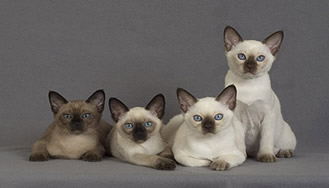 Week 12. Week 12.
Tonk's color can change all their life. Blues can get lighter just as kittens but generally tonks get darker with age. At this point the color changes slow down although there is still significant color change until they are an adult. An older tonk who suddenly becomes light like a kitten may be ill.
Observe. The color on the back of the ear for 3 and 4 (brown/Dense) is almost covering the whole back of the ear - long after 1 and 2 (Black/Dense). The masks of 3 and 4 are sill behind 1 and 2 in development and but will fill in more. Although 2, 3 and 4 are all points, 2 as a Natural has more body color than and 3 and 4 which are Champagnes. The paw pads of 1 and 2 are really intense now.
In the introduction, I said "The various Tonkinese coat pattern genes suppress body color by temperature. The amount of body color suppression varies among the three coat patters of Point, Mink, and Solid." In Week 11, I said that the point color is also effected by the coat pattern gene such that their points are not quite as intense in all 3 patterns compared to other breeds with a true solid color coat pattern. The third thing effected by the coat pattern gene is the eye color. All the kittens are born with blue eyes. But adult eye color is based on the amount of pigment color suppression which varies for each coat pattern. The pointed pattern blue eyes are not blue pigment but almost total suppression of pigment - just like the body color. What you see is light reflection like blue sky. We sometimes refer to seeing "red flash" in the eyes of points. That means we are seeing the retina in the back of the eye because there is no pigment to interfere. Our solid pattern (which is not a true solid coat pattern - just a poor name we choose for a weak contrast) has little pigment suppression so we see green to yellow-green pigment. The eye color of our minks is complex. It is a mix of pigment and reflected light that results in the aqua eye color. Because the color is a mix of two totally different mechanisms (reflected light and pigment), it can appear different in different light sources (natural light, incandescent light vs florescent light). The minks have the widest color range varying between blue and yellow/green since either mechanism can be stronger than the other. A mink with eyes on the blue side does not usually have red flash. We want it aqua which is right in the middle for a show cat based on the standard, but fortunately all the variations are pretty.
De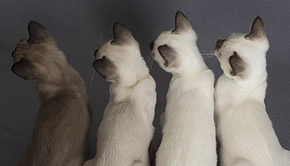 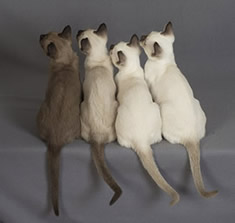 velopment. There are 2 important time periods for a well socialized tonk. Hopefully a tonk should start with a good personality genetically. But they can be damaged by poor socialization once born. The critical time for human socialization is the first 4-6 weeks of a kittens life (supported by studies at Cornell etc). Pet buyers frequently ask are the kittens caged. Frankly good breeders either cage or provide a secure situation for newborns for fairly obvious safety reasons. The real issue is how much human interaction with humans do the kittens get in these first critical weeks. They need human interaction several times a day. Feral cats may never be able to be socialized. This is not because they have bad genes but due to a lack of human interaction during the fist critical weeks.. velopment. There are 2 important time periods for a well socialized tonk. Hopefully a tonk should start with a good personality genetically. But they can be damaged by poor socialization once born. The critical time for human socialization is the first 4-6 weeks of a kittens life (supported by studies at Cornell etc). Pet buyers frequently ask are the kittens caged. Frankly good breeders either cage or provide a secure situation for newborns for fairly obvious safety reasons. The real issue is how much human interaction with humans do the kittens get in these first critical weeks. They need human interaction several times a day. Feral cats may never be able to be socialized. This is not because they have bad genes but due to a lack of human interaction during the fist critical weeks..
The second critical development is social interactions with other cats. Cars are not a herding animal. They need more time than puppies to learn good play behaviors from other cats and gain confidence. Breeders let kittens go at various ages but never ever get a kitten before 12 weeks. They need that time with other cats to gain confidence and not be scared in their new home. They also need a 12 week vaccine for health reasons. Kittens age sort like humans but at 1 week for a kitten vs 1 year for humans. An analogy is the development difference of a 9 or 10 year old vs a 12 year old child. I can only tell you there is a big difference between a 11 week old kitten and a 12 week old. Any breeder who sells or buyer who purchases a kitten younger than 12 weeks is not putting the kitten's needs first. |
 ay 4:
ay 4:
 evelopment:
evelopment:  Ears more open but just a little response to noise. They do not seem to see and no response to movement in front of their eyes.
Ears more open but just a little response to noise. They do not seem to see and no response to movement in front of their eyes. W
W

 hey are now "popcorning". A term we use to describe their jumping around with stiff legs some times even backwards. They remind us of popcorn popping. They are not shy and busy exploring beyond their cage and curious about objects they find.
hey are now "popcorning". A term we use to describe their jumping around with stiff legs some times even backwards. They remind us of popcorn popping. They are not shy and busy exploring beyond their cage and curious about objects they find.  eek 6.
eek 6. >eek 7.
>eek 7. ek 8.
ek 8. T
T eek 9.
eek 9. eek 10.
eek 10. eek 11.
eek 11. Week 12.
Week 12.

 velopment. There are 2 important time periods for a well socialized tonk. Hopefully a tonk should start with a good personality genetically. But they can be damaged by poor socialization once born. The critical time for human socialization is the first 4-6 weeks of a kittens life (supported by studies at Cornell etc). Pet buyers frequently ask are the kittens caged. Frankly good breeders either cage or provide a secure situation for newborns for fairly obvious safety reasons. The real issue is how much human interaction with humans do the kittens get in these first critical weeks. They need human interaction several times a day. Feral cats may never be able to be socialized. This is not because they have bad genes but due to a lack of human interaction during the fist critical weeks..
velopment. There are 2 important time periods for a well socialized tonk. Hopefully a tonk should start with a good personality genetically. But they can be damaged by poor socialization once born. The critical time for human socialization is the first 4-6 weeks of a kittens life (supported by studies at Cornell etc). Pet buyers frequently ask are the kittens caged. Frankly good breeders either cage or provide a secure situation for newborns for fairly obvious safety reasons. The real issue is how much human interaction with humans do the kittens get in these first critical weeks. They need human interaction several times a day. Feral cats may never be able to be socialized. This is not because they have bad genes but due to a lack of human interaction during the fist critical weeks..